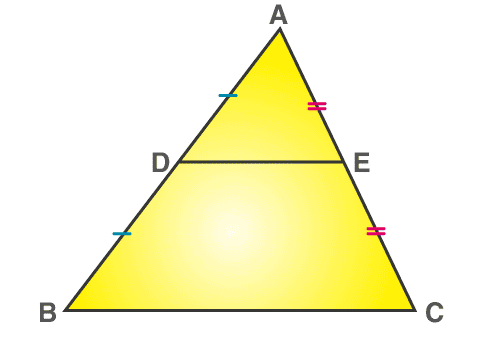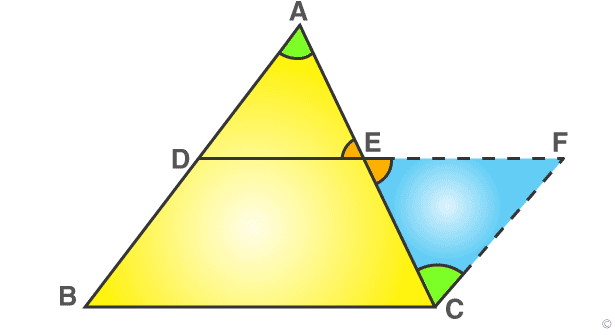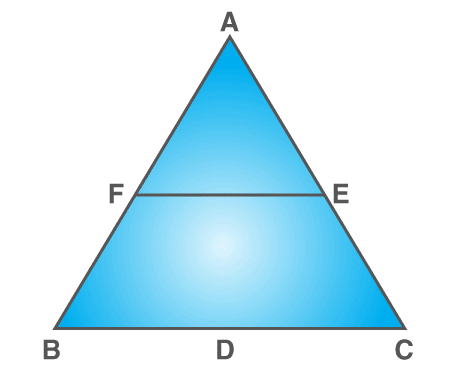- Books Name
- ABCD CLASSES Mathematics Book
- Publication
- ABCD CLASSES
- Course
- CBSE Class 9
- Subject
- Mathmatics
The Mid-Point Theorem
geometry is one of the significant and essential branches of mathematics. This field deals with the geometrical problems and figures which are based on their properties. One of the important theorems in the field of geometry that deals with the properties of triangles are called the Mid-Point Theorem.
The theory of the midpoint theorem is used in coordinate geometry stating that the midpoint of the line segment is an average of the endpoints. Both the ‘x’ and the ‘y’ coordinates must be known for solving an equation using this theorem. The Mid-Point Theorem is also useful in the fields of calculus and algebra.
MidPoint Theorem Statement
The midpoint theorem states that “The line segment in a triangle joining the midpoint of two sides of the triangle is said to be parallel to its third side and is also half of the length of the third side.”

MidPoint Theorem Proof
If the line segment adjoins the midpoints of any of the sides of a triangle, then the line segment is said to be parallel to all the remaining sides, and it measures about half of the remaining sides.
Consider the triangle ABC, as shown in the above figure,
Let E and D be the midpoints of the sides AC and AB. Then the line DE is said to be parallel to the side BC, whereas the side DE is half of the side BC; i.e.
DE = (1/2 * BC).
Now consider the below figure,

Construction- Extend the line segment DE and produce it to F such that, EF = DE.
In triangle ADE and CFE,
EC = AE —– (given)
∠CEF = ∠AED (vertically opposite angles)
∠DAE = ∠ECF (alternate angles)
By ASA congruence criterion,
△ CFE ≅ △ ADE
Therefore,
∠CFE = ∠ADE {by c.p.c.t.}
∠FCE= ∠DAE {by c.p.c.t.}
and CF = AD {by c.p.c.t.}
∠CFE and ∠ADE are the alternate interior angles.
Assume CF and AB as two lines that are intersected by the transversal DF.
In a similar way, ∠FCE and ∠DAE are the alternate interior angles.
Assume CF and AB are the two lines that are intersected by the transversal AC.
Therefore, CF ∥ AB
So, CF ∥ BD
and CF = BD {since BD = AD, it is proved that CF = AD}
Thus, BDFC forms a parallelogram.
By the properties of a parallelogram, we can write
BC ∥ DF
and BC = DF
BC ∥ DE
and DE = (1/2 * BC).
Hence, the midpoint theorem is proved.
MidPoint Theorem Formula
In Coordinate Geometry, the midpoint theorem refers to the midpoint of the line segment. It defines the coordinate points of the midpoint of the line segment and can be found by taking the average of the coordinates of the given endpoints. The midpoint formula is used to determine the midpoint between the two given points.
If P1(x1, y1) and P2(x2, y2) are the coordinates of two given endpoints, then the midpoint formula is given as:
Midpoint = [(x1 + x2)/2, (y1 + y2)/2]
The converse of the MidPoint Theorem
The converse of the midpoint theorem states that ” if a line is drawn through the midpoint of one side of a triangle, and parallel to the other side, it bisects the third side”.
Midpoint Theorem Example
The example is given below to understand the midpoint theorem.
Example:
In triangle ABC, the midpoints of BC, CA, AB are D, E, and F, respectively. Find the value of EF, if the value of BC = 14 cm

Solution:
Given: BC = 14 cm
If F is the midpoint of AB and E is the midpoint of AC, then using the midpoint theorem:
EF = 1/2 (BC)
Substituting the value of BC,
EF = (1/2) × 14
EF = 7 cm
Therefore, the value of EF = 7cm.
80,202
The Mid-Point Theorem can also be proved using triangles. Suppose two lines are drawn parallel to the x and the y-axis which begin at endpoints and are connected through the midpoint, then the segment passes through the angle between them resulting in two similar triangles. This relation of these triangles forms the Mid-Point Theorem.

 Vision classes
Vision classes
